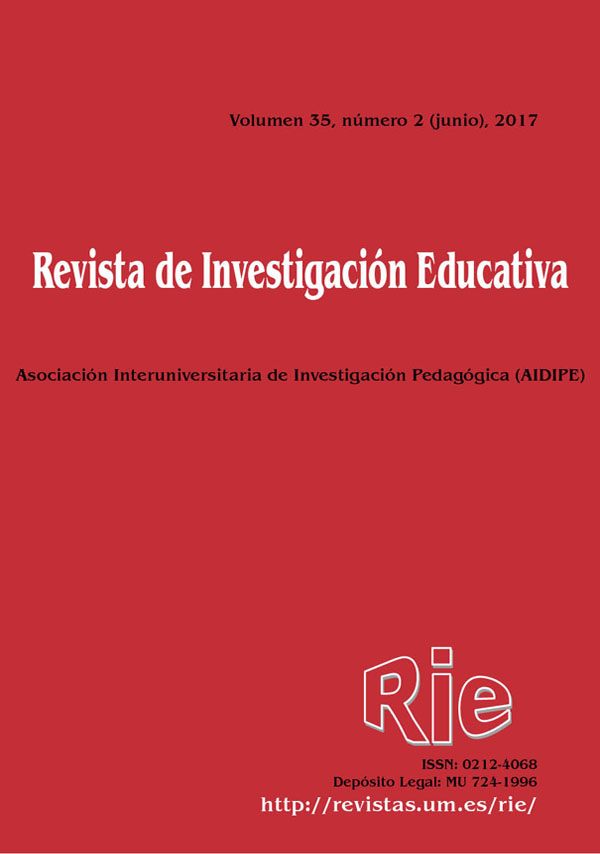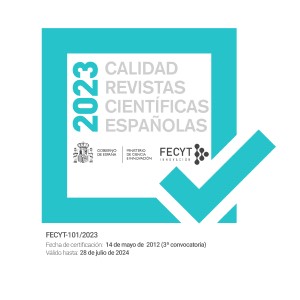The relationship of gender, time orientation, and achieving self-regulated learning
Resumen
The present study has three objectives: i) to test a theoretical model of academic achievement modulated by self-regulated learning; ii) to analyze significant differences between self-regulated learning means and time patterns depending on the gender of the participants; and iii) to identify self-regulated learning profiles toward academic achievement based on gender. The data were obtained from a sample of 192 university students in education degrees who were administered three instruments: a Future Time Orientation subscale by Zimbardo and Boyd, (1999); the 2x2 Achievement Goals Scale by Elliot and McGregor (2001), and a Learning Regulation subscale by Vermunt (1998). In addition, they answered a question about their mean grade point average up to that point in the academic degree studied. The results indicate a significant and positive relationship between the future time orientation, approach goals, and external regulation strategies. Significantly higher scores are observed in women than in men on key academic performance variables, although the effect size was not large. The gender differences are exclusively quantitative. In both groups, the characteristics of the learner profiles are somewhat similar, with no important differences observed for the gender condition. In general, avoidance goals and external regulation strategies can lead to success in academic achievement, as long as they are accompanied by a future orientation, internal regulation, and approach goals.
Descargas
Citas
Bentler, P. M. (1990). Comparative fit indexes in structural models. Psychological Bulle- tin, 107, 238-246.
Bollen, K.A., & Stine, R.A. (1992). Bootstrapping goodness-of-fit measures in structural equation models. Sociological Methods and Research, 21, 205–229.
Bouffard, L., Bastin, E., & Lapierre, S. (1994). The personal future in old age. In Z. Zaleski (Ed.). Psychology of future orientation. Lublin, Poland: Lublin University Press. Byrne, B.M. (2010). Structural equation modeling with AMOS. New York, NY: Routledge.
Cano, F. (2000). Diferencias de género en estrategias y estilos de aprendizaje. Psicothema, 12, 360-367.
Cerezo, M.T. & Casanova, F. (2004). Diferencias de género en la motivación académica de los alumnos de Educación Secundaria Obligatoria. Revista Electrónica de Investigación Psicoeducativa, 2(1), 97-112.
Cohen, J. (1988). Statistical power analysis for behavioral sciences (2º ed.). Hillsdale, NJ: Erlbaum.
Daltrey, M., & Langer, P. (1984). Development and evaluation of a measure of future time perspective. Perceptual and Motor Skills, 58, 719-725.
De Bilde, J., Vansteenkiste, M., & Lens, W. (2011). Understanding the association between future time perspective and self-regulated learning through the lens of self-determination theory. Learning and Instruction, 21, 332-344.
De la Fuente Arias, J. (2002). Perspectivas recientes en el estudio de la motivación: la Teoría de la Orientación a Meta. Escritos de Psicología 6, 72-84.
Díaz-Morales, J. F. (2006). Estructura factorial y fiabilidad del Inventario de Perspectiva Temporal de Zimbardo. Psicothema, 18(3), 565-571.
Elliot, A. J., & McGregor, H. A. (2001). A 2 × 2 achievement goal framework. Journal of Personality and Social Psychology, 80, 501–519.
Elliot, A.J. (1999). Approach and avoidance motivation and achievement goals. Educa- tional Psychologist, 34, 169-189.
Entwistle, N. J., Hanley, M., & Hounsell, D. J. (1979). Identifying distinctive approaches to studying. Higher Education, 8, 365-380.
Fraisse, P. (1967). Psychologie du temps (2ª edición). Paris: PUF
Gjesme, T. (1983). On the concept of future time orientation: Considerations of some functions’ and measurements’ implications. International Journal of Psychology, 18, 443-461.
González, M.L., & Daura, F.T. (2012). El aprendizaje auto-regulado y su vinculación con la perspectiva de futuro. Revista de orientación Educacional, 26(50), 47-72.
Gutiérrez-Braojos, C. (2015). Future time orientation and learning conceptions: effects on metacognitive strategies, self-efficacy beliefs, study effort and academic achieve- ment. Educational Psychology, 35(2), 192-212. https://dx.doi.org/10.1080/01443410.2013.858101
Gutiérrez-Braojos, C.; Salmerón-Pérez, H. & Muñoz-Cantero, J.M. (2014). El efecto modulador de los patrones temporales sobre el logro en el aprendizaje autorregulado. Revista de Psicodidáctica, 19(2), 267-287. https://dx.doi.org/10.1387/RevPsicodidact.10066
Hayes, A.F. (2013). Introduction to mediation, moderation, and conditional process analysis: A regression-based approach. London: The Guilford Press
Holman, E.A., & Silver, R.C. (1998). Getting “stuck” in the past: temporal orientation and coping trauma. Journal of Personality and Social Psychology, 74(5), 1146-1163.
Honora, D., & Freeman, J. (2001). Future time perspective as a correlate to academic achievement and school membership among urban African American adolescents. Adolescence, 42(167), 525-538.
Horstmanshof, L., & Zimitat, C. (2007). Future time orientation predicts academic engagement among first-year university students. British Journal of Educational Psychology, 77(3), 703-718. https://dx.doi.org/10.1348/000709906X160778
Husman, J., & Lens, W. (1999). The role of the Future in Student Motivation. Educational Psychologist, 34, 113-125.
James, W. (1890). The principles of psychology. New York: Holt.
Lapierre, S., Bouffard, L., & Bastin, E. (1997). Personal goals and subjective well-being in later life. International Journal of Aging and Human Development, 45, 287-303.
Lens, W., & Moreas, M. (1994). Future time perspective: individual and societal approach. In Z. Zaleski (Ed.), Psychology of future orientation. Polonia: Towarzystwo Naukowe KUL.
Lens, W. (1986). Future time perspective: A cognitive-motivational concept. In D.R. Brown & J. Veroff (Eds.), Frontiers of motivational psychology (pp. 173-190). New York: Springer-Verlag.
Lens, W. (2001). How to combine intrinsic task-motivation with the motivational effects of the instrumentality of present tasks for future goals. In A. Efklides, J. Kuhhl & R.M, Sorrentino (Eds.). Trends and prospects in motivation research (pp. 23-36), New York, NY: Kluver.
Lewin, K. (1942). Time perspective and morale. In G. Watson (eds.): Civilian morale. Boston Houghton Mifflin
Marshall, J.C., & Merrit, S.L. (1986). Reliability and construct validity of the learning style questionnaire. Educational and Psychological Measurement, 46, 257-262.
Martínez-Fernández, J. R., García-Ravidá, L., González-Veláquez, L., Gutiérrez-Braojos, C., Poggioli, L.,Ramírez-Otálvaro, P., & Tellería,M. B. (2009). Learning pattern inven- tory (in Spanish). Internal documentofthe PAFIU research team. Barcelona: Universitat Autònoma de Barcelona.
Nuttin, J. (1980). Motivation et perspective d´avenir. Belgica: Presses Universitaires. Nuttin, J. (1985). Future time perspective and motivation: theory and research method. Hills-dale, NJ: Erlbaum.
Peetsma, T., Hascher, T., Van der Veen, I., & Roede, E. (2005). Relations between ado- lescents’ self-evaluations, time perspectives, motivation for school and their achie- vement in different countries and at different ages. European Journal of Psychology of Education, 20, 209-225.
Peetsma, T.T.D. (2000). Future time perspective as a predictor of school investment. Scandinavian Journal of Educational Research, 44, 179-194.
Pintrich, P. R. (2004). A conceptual framework for assessing motivation and self- regulated learning in college students. Educational Psychology Review, 16, 385–407.
Roberts, W.A. (2002). Are animals stuck intime? Pschological Bulletin, 128, 473-489.
Roeckelin, J.E. (2000), The concept of time in psychology. Westport, Connecticut: Green- wood Press.
Salmerón Pérez, H., Gutiérrez-Braojos, C., Salmerón-Vílchez, P., & Rodríguez Fernández, S. (2011). Metas de logro, estrategias de regulación y rendimiento académico en diferentes estudios universitarios. Revista de Investigación Educativa, 29(2), 467-477
Schmeck, R.R., Ribich, F.D., & Ramanaiah, N. (1977). Development of a self-report inventory for assessing individual differences in learning processes. Applied Psy- chological Measurement, 1, 413-431.
Shell, D. F., & Husman, J. (2001). The multivariate dimensionality of personal control and future time perspective in achievement and studying. Contemporary Educational Psychology, 26, 481-506.
Simmons, J. Dewite, S., & Lens, W. (2000). Wanting to have versus wanting to be: the influence of instrumentality on goal orientation. British Journal of Psychology, 91, 335-351.
Suárez, J. M., Anaya, D., & Gómez, I. (2004). Diferencias diagnósticas en función del género respecto a la utilización de estrategias autorreguladoras en estudiantes universitarios. Revista de Investigación Educativa, 22(1), 245-258.
Suddendorf, T., & Corballis, M.C. (1997). Mental time travel and the evolution of the human mind. Genetic, Social and General Psychology Monographs, 123, 133-167.
Thiébaut, E. (1998). La perspective temporelle, un concept a la recherched’une défini- tion opérationnelle. L’Année Psychologie, 98, 101-125.
Trommsdorff, G. (1983). Future orientation and socialization. Journal of International Psychology, 18, 381-406.
Vansteenkiste, M., Simons, J., Lens, W., Sheldon, K. M., & Deci, E. L. (2004). Motivat- ing learning, performance, and persistence: The synergistic role of intrinsic goals and autonomy-support. Journal of Personality and Social Psychology, 87, 246-260.
Vermunt, J. (1998). The regulation of constructive learning processes. British Journal of Educational Psychology, 68, 149-171.
Weinstein, C. E. (1987). Learning and study strategies inventory (LASSI). Clearwater, FL: H & H Publishing Company.
Wigfield, A., & Eccles, J.S. (2000). Expectancy-Value Theory of Achievement Motivation.
Contemporary Educational Psychology, 25, 68-81.
Yonge, G.D. (1974). Dimensions of time experiences. Social behavior and personality, 2, 119-124.
Zalesky, Z. (1994). Psychology of future orientation. Poland: Lublin University Press.
Zimbardo, P. G., Keough, K. A., & Boyd, J. N. (1997). Present time perspective as a predictor of risky driving. Personality and Individual Differences, 23(6), 1007-1023.
Zimbardo, P.G. & Boyd, N. (1999). Putting time in perspective: a valid, reliable, indi- vidual-differences metric. Journal of Personality and Social Psychology, 17(6), 1271-1288.
Zimbardo, P.G., & Boyd, N. (2008). The time paradox: The new psychology of time that will change your life. London: Rider.
Zimmerman, B. J. (2000). Attaining self-regulation: a social cognitive perspective. In M. Boekaerts, P.R. Pintrich & M. Zeidner (Ed.). Handbook of self-regulation (pp. 13-38). San Diego: Academic Press.
Zimmerman, B. J., & Schunk, D. H. (2009). Self-Regulated Learning and Academic Achieve- ment. Theoretical Perspectives (2ª ed.). New York: Routledge.
Zimmerman, B. J., & Schunk, D. H. (2011). Self-regulated learning and performance. In B.J. Zimmerman & D.H. Schunk (Eds.), Handbook of self-regulation of learning and performance (pp. 1-12). New York: Routledge.
Las obras que se publican en esta revista están sujetas a los siguientes términos:
1. El Servicio de Publicaciones de la Universidad de Murcia (la editorial) conserva los derechos patrimoniales (copyright) de las obras publicadas, y favorece y permite la reutilización de las mismas bajo la licencia de uso indicada en el punto 2.
2. Las obras se publican en la edición electrónica de la revista bajo una licencia Creative Commons Reconocimiento-NoComercial-SinObraDerivada 3.0 España (texto legal). Se pueden copiar, usar, difundir, transmitir y exponer públicamente, siempre que: i) se cite la autoría y la fuente original de su publicación (revista, editorial y URL de la obra); ii) no se usen para fines comerciales; iii) se mencione la existencia y especificaciones de esta licencia de uso.
3. Condiciones de auto-archivo. Se permite y se anima a los autores a difundir electrónicamente las versiones pre-print (versión antes de ser evaluada) y/o post-print (versión evaluada y aceptada para su publicación) de sus obras antes de su publicación, ya que favorece su circulación y difusión más temprana y con ello un posible aumento en su citación y alcance entre la comunidad académica.









